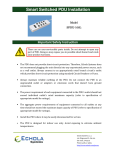Download OMS series MxN switch user manual
Transcript
Installation & Operating Guide
OMS Series Matrix Switch
________________________________________________________________________________
Echola Systems L.L.C
1161 Ringwood Ct, Ste 100
San Jose, CA-95131
Phone: 408 321 9663
Fax: 408 321 9663
http://www.echola.com/optical
________________________________________________________________________________
Installation
The OMS series switch is a non blocking MxN all-optical
cross-connect switch that allows light to be switched
from any input port to any output port.
The figure on right side illustrates how a 4x4 matrix
switch works. The 4x4 matrix is essentially eight 1x4
switches connected as shown. It shows simple config
where the switch is programmed to connect input port 1
to output port 1, input port 2 to output port 3, input port
3 to output port 2 and input port 4 to output port 4. But
it can be programmed to switch light to any input port
to any output port through GUI or CLI command. The
switching time is about 1 second. The typical applications
include patch panel/test lab automation. We offer both
single-mode and multi-mode versions of the switch.
OUTPUTS
INPUTS
RS232
It comes in different port configurations but above figure on right shows a 16x16 for illustration
purpose. There are 16 input optical connectors on left and 16 output optical connectors on right. You
can connect up to 16 single strand optical fibers to left connectors where you want the light to be
switched from and similarly 16 on the output side where light to be switched to. If you want to
connect both Rx/Tx pairs then you can connect up to 8 such pairs on input side and 8 on output. Even
though ports are grouped as input and output ports they are bi-directional ports which means the
input and output can be swapped.
OMS series switch provides a serial (RS232) and an Ethernet (RJ45) port connectivity for management.
Serial port is only used in special situations such as to debug network connectivity if OMS series
switch is not reachable through Ethernet.
Configuring OMS series switch
You might require a Laptop or a PC to configure OMS series switch with an IP address before
connecting to your network. You can use either serial or Ethernet port to configure IP. If you use
serial port using supplied null modem cable then you would need to configure serial for 38400 baud
rate with 8-N-1 to access OMS series switch. If you use Ethernet then you would need to configure
the PC or Laptop’s IP to match OMS series switch’s default network. The default network
configuration and Login information is as follows
IP Address: 10.1.1.100
Mask: 255.255.255.0
Gateway: 10.1.1.1
DNS: 10.1.1.1
“root” password: omsctl
Other non-root default user:
Username: omsctl
Password: omsctl
Configuring Static IP
The management module runs an embedded version of Linux, so anyone familiar with Linux will find
it easy to use. But we provide a CLI command which can be used to configure and use most of the
features. The name of the CLI is “omsctl”. So, to configure a static IP address you can use following
syntax.
# omsctl -i 192.168.1.10 -m 255.255.255.0 -g 192.168.1.1
“omsctl -?” shows detailed omsctl command options with examples.
The above command configures IP address of OMS series switch as 192.168.1.10 with network mask
255.255.255.0 and gateway & DNS as 192.168.1.1. Once the IP is configured from a PC or a Laptop
using Ethernet or serial port, you can then connect OMS series switch to your network and access it
using “telnet” or “ssh”.
Configuring Dynamic IP
If you have a DHCP server running on your network and you may want to dynamically assign an
available IP address to OMS series switch by using following option.
# omsctl -D
Make sure you know the assigned IP address to login using “telnet” or “ssh”.
Configuring Hostname
You can also change the hostname of OMS series switch switch using “omsctl”.
# omsctl –h OMS500-SW-1
The above command changes hostname of OMS series switch to OMS series switch-SW-1.
Configuring DNS/Nameserver
To configure a DNS or Nameserver, you can use “-n” option of omsctl.
# omsctl –n 192.168.1.11
Configuring Syslog Server
To send system generated events to an external syslog server, use “–S” option of omsctl. You have to
specify the address of the syslog server which will receive these event logs. (Note: this option only
available in software version 2.0 and above).
# omsctl –S 192.168.1.200
Version Info
The following command shows hardware and software versions and serial number of the switch.
# omsctl –v
Other Administrative commands
Most of other administrative functions can be done using standard Linux commands. For example, to
change the password use “passwd” command from the Linux prompt and to add new user use
“useradd” command. You have to be “root” user in order to add a new user.
Operation
To simply the operation, all functions are provided in a single command called “omsctl”. omsctl
provides 3 major functions
1. Network & Host configuration (allowed only as “root” user)
2. Switch Control & Status
3. Port group Management
Network & Host configuration
The following are the commands used to configure network.
1. To configure static IP
# omsctl -i <ip> -m <mask> -g <gw>
2. To use DHCP (dynamic IP)
# omsctl -D
3. To configure hostname alone
# omsctl -h <hostname>
4. To configure a DNS or Nameserver, you can use “-n” option of omsctl.
# omsctl –n <dns_server_ip>
5. To configure syslog server to receive OMS series switch’s events
# omsctl –S <syslog_server_ip>
For details on above commands refer to above installation section.
Switch Control
In order to cross connect an input port to an output port or a group of ports, the following command
can be used.
$ omsctl -p { <input_port#> <output_port#> } | <port_group> [-t <secs>]
Note that the “{}” (braces) groups options and “|” is equivalent to “or”. If the options are in square
brackets “[]” then it is optional.
For example:
$ omsctl -p 1 4
switch input port 1 to output port 4. Note, there should be space between p,1 and 4.
$ omsctl -p config1
switch ports mentioned in group named config1. Refer to port group management section
for creating port groups.
$ omsctl -p 2 1 -t 120
switch input port 2 to output port 1 after 120 secs (delayed switching)
Switch Status
Following command shows the status of ports, which input port is mapped to which output port or
status of ports in a pre-defined group.
$ omsctl -s [ <input_port#> ]
For example:
$ omsctl -s
shows all ports status as follows. It shows which input port connected to which output and
also shows the active group.
All Ports Status
========================
In Port | Out Port
========================
1
| 4
2
| 1
3
| 5
4
| 12
5
| 14
6
| 2
7
| 6
8
| 7
9
| 9
10
| 11
11
| 10
12
| 8
13
| 13
14
| 3
15
| 16
16
| 15
-----------------------------------Active Group: config1
------------------------------------
$ omsctl -s 2
shows which output port the port2 is cross connected to.
$1
Port group Management
Port group management commands provide convenience of switching bunch of ports together
identified by a name. Group name can be any alpha-numeric name. Group name can not be just a
number or start with a number. For example group name can not be “10” or 10gp1.
1. To create a new group
$ omsctl -c <port_group> [ -f <map_file> ]
2. To update existing group
$ omsctl -u <port_group> {-a | -r <input_port#> <output_port#>}
3. To delete a group
$ omsctl -d <port_group>
4. To delete all groups
$ omsctl -R
5. To list ports in a group
$ omsctl -l [<port_group> | <input_port#>]
For example:
$ omsctl -c config1
creates empty group named "config1"
$ omsctl -u config1 -a “1 4”
add a port map where input port 1 would connect to output port 4 to config1 group
if you want to add may port maps at a time, use -f option as shown in one of following
example.
$ omsctl -u config1 -a “2 1”
add a port map where input port 2 would connect to output port 1 to config1 group
$ omsctl –l config1
show the port map for the port group config1
========================
In Port | Out Port
========================
1
| 4
2
| 1
----------------------------------$ omsctl -u config1 -r “1 12”
replace input port 1 entry in the port map of config1 to make now connect to output port
12 instead of previous 4
$ omsctl –l config1
========================
In Port | Out Port
========================
1
| 12
2
| 1
-----------------------------------
The following example shows how to create group with multiple port maps in one go. Let use
the following 4x4 configuration for illustration purpose.
$ omsctl -c config1 -f testconfig.txt
create port group config1 with port maps defined in the file testconfig.txt. you can use vi
editor and create this file. In the above example, the input port 1 is connected to output
port1, input port 2 is connected to output port 3, input port 3 is connected to output port
2 and input port 4 is connected to output port 4. So the file testconfig.txt would have 4
lines with input and corresponding output ports separated by space as shown below.
1
2
3
4
1
3
2
4
Now listing the config1 would show
$ omsctl –l config1
========================
In Port | Out Port
========================
1
| 1
2
| 3
3
| 2
4
| 4
----------------------------------Now if you want to apply this group so that it connect all ports as per this group, just issue the
command omsctl -p config1.
$ omsctl -d config1
deletes group config1
$ omsctl –R
delete all groups in the database.
Web interface
In order to access OMS series switch web interface you will have to use its IP address in URL address
bar of the web browser. The first page you will see is the management page where you control all
ports. Web interface has a main menu tab with following pages…
Management page
The management page of OMS series switch allows controlling the matrix. You can either individually
switch each input port to output port or all by using ‘Submit All’ button at once.
Setup page
Setup page allows you to change Hostname, Static IP address configuration and Dynamic IP (DHCP).
Initially it shows the current set values. You can change them by clicking on the corresponding field.
Note that the changing IP, Gateway, Mask or DHCP setting would make switch to reboot!
Device Info page
Device Info page shows hardware and software information such as model and version.
Help page
This page shows the complete user’s manual.
Automating OMS Switch using TCL scripts
In order to automate Echola’s Layer 1 switches you would need to write tcl/expect based script. The
tcl and expect scripting languages are easy to learn. We have given an example script written for OMS
series switch at the end which you can modify to suit your need. There are tons of online sources for
learning tcl & expect. The following provides quick high level overview of tcl and expect
http://cplug.org/t/uploads/2009/02/tcl-expect.pdf. There is a good book from O’Reilly which
provides great insight into expect language itself: “Exploring Expect: A Tcl-based Toolkit for
Automating Interactive Programs (Nutshell Handbooks)”.
Running scripts from Unix/Linux systems
If you want to run the script from a Unix/Linux based machines then there is possibility that you may
be already having these tools on your system. Check if it’s already been installed by typing “expect”
from Unix/Linux prompt. If it is not then you will have to install it using package install tool for that
particular flavor of Unix/Linux. For instance, on Fedore core Linux, you can use “yum install tcl
expect” to install tcl and expect.
Running scripts from Windows
For windows based systems you can install windows free community version of ActiveTcl from
Activestate http://www.activestate.com/activetcl/downloads. Expect is not available yet for 64bit
version of Windows 7/Vista. So you will need to download 32bit version for ActiveTcl first and then
make sure to install “expect” using command “teacup install Expect”.
Also you need to enable “telnet” client on Windows before running any scripts. In order to enable
telnet on Windows follow these steps
Start
Control Panel
Programs And Features
Turn Windows features on or off
Check Telnet Client
Hit OK
After that you can start Telnet via Command Prompt to check if it works.
The following sample script actually login into OMS series switch/fc811 switch and issue a switch
command then check whether the switch command was successful and return the result before
terminating the telnet session. This script takes argument (port number and state of the port (on/off))
from commands line argument. Cut and Paste the following script on to any editor and save as
“romsctl”. Then you can run the script by issuing romsctl -p <port#> on|off. For instance, to switch
port 2 to ON, you can call script as romsctl -p 2 on. Make sure you have proper path set for expect on
first line “#!/usr/bin/expect” for Unix/Linux based systems. For windows you will have to uncomment
‘ exec’ and ‘package’ commands as mentioned in the script. All comments inside ‘#’ provide more info
on what the script is doing.
The Sample Tcl/Expect script
#!/usr/bin/expect
##############################################################################
# This script switches the given port and verifies if the port is switched from a remote machine
# that’s why its called romsctl!
#
Command Usage: romsctl -p <input_port#> <output_port#>
##############################################################################
# For windows uncomment following
# exec tclsh "$0" ${1+"$@"}
# package require Expect
# Check number of arguments passed to this command if < 3 then spit out error & exit
if { $argc < 3 } {
puts "Usage: romsctl -p <input_port#> <output_port#>\n"
exit 1
}
# Set telnet host, username, password and other parameters, modify these to reflect your setup
set hostname "192.168.2.20"
set username "omsctl"
set password "omsctl"
set prompt "omsctl@.*\$"
set input_port [lindex $argv 1]
set output_port [lindex $argv 2]
set commandcontrol "omsctl -p $input_port $output_port" # use the CLI to control
set commandstatus "omsctl -s $input_port "
# use the CLI to check status
# Display info.
puts "Connecting to $hostname."
# Connect to the telent server using the "spawn" command.
spawn telnet $hostname
#spawn C:\Putty\putty.exe -telnet $hostname
# Wait for a login prompt.
expect -re "(Name|login|Login|Username).*:.*" {
# Login prompt received. Send user name to OMS series switch.
send "$username\r"
} eof {
# No login prompt received. Display an error.
puts "could not connect\n"
}
# Wait for a password prompt from the Unix server.
expect "Password:" {
# Password prompt received. Send the password.
send "$password\r"
}
# Wait for the switch prompt.
expect -re $prompt {
# Issue omsctl command to switch given port
send "$commandcontrol\r"
}
# Wait for the switch prompt again to check status.
expect -re $prompt {
# Issue omsctl command to check status
send "$commandstatus\r"
}
# Discard echoed command - we need only the status
expect "$commandstatus\r"
# Discard unwanted prompt as well
expect -re "(.*)$prompt"
#Debug
#puts "\nGOT*****$expect_out(buffer)***************\n"
#puts "\n GOTS ####$expect_out(1,string)#####\n"
# Save remaining to buffer 'data'
set data $expect_out(1,string)
# Check return status and display result accordingly
switch -re $data {
$input_port { puts "Input Port $input_port is connected" }
default { puts "Port $input_port is not connected" }
}
# Terminate telnet
send "exit\r"
OMS Series Switch Specifications
Standard Configurations
Troubleshooting
If you use telnet and is very slow, it could be due to name server / DNS issue. Make sure
you have name server configured correctly (-n option). Try “ping <name_server_ip>” to
see if name server configured can be reached from fc811. If you don’t have dns on your
network then you can just remove file “/etc/resolv.conf” and see if it works normal.
All the group information is stored in a hidden XML database file. If for some reason this
file is corrupted, the system will recover from this error by trying to copy the backup
database file. If this happens it will throw a warning message but it is not guaranteed that
all the group information will be restored correctly. In that case you may need to recreate
missing groups.
For adding new users Linux’s “useradd” command can be used. You have to be “root” in
order to add new user to the system.
Contact Info
If you have any technical questions and need help you can send email to [email protected] or call
us at 408-321-9663 ext 2. You can also download latest documents and software from our website
www.echola.com/optical.



























